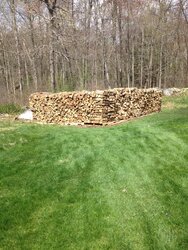I got my chimney swept today and had terrible creosote build up. My sweeper was not happy, said I must have burned wet wood, which I did, causing stage 3 creosote. Fail. So anyway, chimney is clean and good to go. I split about 4-5 cord of wood back in April as soon as the snow melted, and stacked it, top covered. I checked the moisture content of a split today and got 45%! This is my first year doing c/s/s and now its mid September and I still don't have dry wood. I am feeling kind of defeated. I refuse to pay $300/cord for split "Seasoned" wood that will be wet anyway. With low oil prices, and after all the investments into wood burning, I may not even burn this year. 



